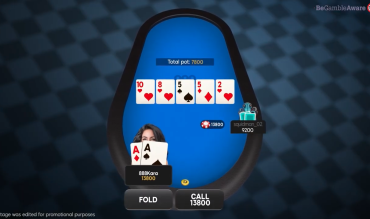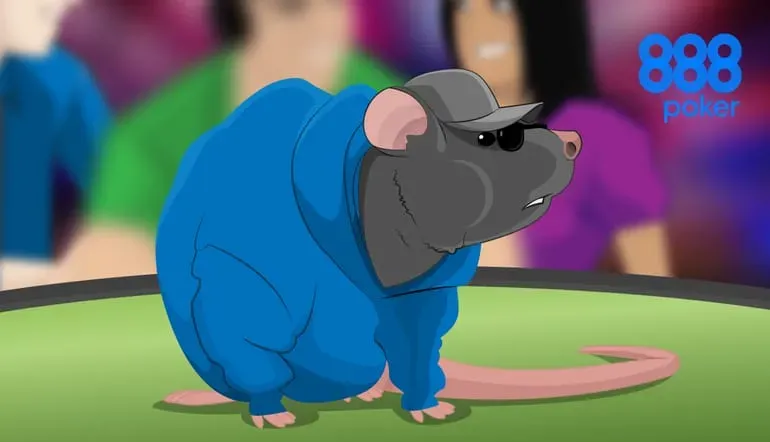Some of the most profitable poker players specialise in heads-up play. Playing one on one vs a single opponent might sound daunting for some.
Perhaps it’s simply more relaxing to fade away into the semi-anonymity of a 6-max or full-ring environment.
But for those looking to boost profits considerably, the world of one-on-one poker games can offer significantly larger returns.
This guide should help in that endeavour and will touch on the following topics:
Why Play Heads-Up?
The simplest incentive to play heads-up poker is that the potential profit margins are a lot higher. In today's ring games, a player is ‘decent’ if they generate a winrate somewhere between 0 and 4bb per hundred hands.
Players with 10bb/100 are either considered insane crushers or are playing in noticeably softer (sometimes ring-fenced) environments.
- What about heads-up players?
It’s not unheard of for heads-up specialists to generate between 10 and 30bb per hundred hands. The potential winrate increase is enormous, especially with careful opponent selection.
Heads-Up Opportunities in Ring Games

Rather than making a complete transition to heads-up play, the simplest way to get involved is to play heads-up when the opportunity arises.
Perhaps we’ve been in one of the following two scenarios in an online environment.
- Scenario 1 - Our ring game has just broken. It’s only us and one other guy who hasn’t yet sat out. A quick glance at the lobby reveals plenty of seats available on tables that are almost full to capacity.
Many players might leave the table and join one that is closer to capacity. Why not stick around and play some heads-up? This scenario could be especially valuable if our opponent seems weak.
- Scenario 2 - We like to multi-table but aren’t finding enough tables in the lobby to get up to our usual number.
Many players might wait and grind a smaller number of tables until a slot opens up. This situation costs valuable grinding time. Why not join some empty tables and be willing to play heads-up when another player joins?
Not only does this allow us to improve our heads-up skill, but it results in potentially much softer games and higher win rates.
It’s generally better to start a new table than hop on a waiting list for a table infested with seasoned regulars.
It might sound surprising, but many ring game regulars are reluctant to play heads-up. So, we are more likely to get weak opposition joining our half-empty table.
Opponent Selection
Our goal should be to play heads-up vs weak opponents. Hopefully, we already have an idea about decent opponents and who we can beat big.
There can sometimes be a fine line between bum-hunting and table selection. Bum-hunting is a type of predatory behaviour. It involves only targeting exceptionally weak players exclusively at the heads-up tables.
- Unfortunately, there is often no clear guideline on where table selection (a recommended discipline) turns into bum-hunting (a type of predatory behaviour).
Just keep in mind that the poker room may be watching. Our goal is to game select well, not to involve ourselves in behaviour that could be unethical.
The term bum-hunting generally applies specifically to heads-up tables. So, it’s unlikely to be bum-hunting on a ring game table where other players can join at any time.
 Opponent Selection Is Essential
Opponent Selection Is Essential
HU SNG vs HU Cash
Let’s assume for a minute that we plan on ditching ring games exclusively for heads-up action.
- We generally have two choices, HU SNGs or HU cash games.
Cash games are often better as they allow us to use our skill edge to greater effect. Once the blinds run down in a heads-up SNG we are entering push/fold territory. There is little if any room for preflop play.
Although we can still generate an edge this way, edges in push/fold preflop wars are generally smaller. The advantage we might create through deeper-stacked postflop play in HU cash games is far more significant.
Another factor to bear in mind is that SNG strategy changes throughout the match as the blind levels shift. This factor can be especially complicated if we are multi-tabling. We would potentially have different starting ranges on several different tables - depending on the respective stack depths.
- Cash games allow for a more consistent strategy across the board since we’ll often start every cash game with 100bb. We could easily rebuy we fall below that stack size.
Of course, our choice will ultimately be dependent on the traffic. If there are no heads-up cash games, we should be willing to play SNGs.
We don’t need to worry about ICM implications in HU SNGs due to the ‘winner takes all’ structure. They function very much like cash games (aside from the rising blind levels).
Rake Considerations
It’s essential to check out the rake numbers if considering heads-up games at the low limits. While HU cash games at 100nl plus are nearly always viable, the same can’t always be the case for the lower-limit games.
- For example, say a room has the same rake structure for heads-up matches as it does for 6-max games. Playing heads-up at lower limits would potentially not be viable. (Rooms rake lower-limit games more heavily).
We spend a lot of time folding in 6-max and full ring games. When we finally pay rake (i.e., enter the pot), it’s because we have a substantial holding. We can expect to win the pot with a relatively high frequency.
In a heads-up match, we’ll be entering the pot well over 50% of the time! This rate means we have to pay a lot of rake for the privilege of playing a lot of close and marginal spots.
The rake fees for heads-up games should be considerably lower relative to 6-max games. It makes sense to make sure we are not entering into a rake trap playing heads-up at the micro-stakes.
In some cases, it could be necessary to play SNGs if the cash rake fees are not viable. Most modern rooms take this into account, But each player should do their own research before joining a game.
Preflop Considerations - Ranges
Are you coming from a ring game background?
You may have spent a decent amount of time constructing and memorising ranges for every position at the table.
The good news here is that there are now only two positions. This fact dramatically limits the number of possible preflop configurations.
|
Heads-up Positions Explained Heads-up positions in poker can sometimes cause confusion. Playing heads-up is different from having the action folded around to us in the SB on a ring game table. In heads-up play, the button is also the small blind. (The BTN also pays the small blind.) These two position names can interchange in a heads-up match. The out-of-position player is the big blind. The difference from ring game occurs postflop. The small blind acts last postflop in a heads-up game. (The small blind is also the button). In a ring game, the small blind will act before the big blind, both preflop and postflop. |
Generally, we’ll either open on the BTN or defend OOP from the BB.
So, at a minimum, we’ll need the following –
- BTN open-raising range
- BB cold-call / 3bet range
- BTN call-3bet / 4bet range
- BB call-4bet / 5bet jam range

That’s pretty much it on a basic level! Specific standard ring game configurations just don’t exist in a heads-up match.
For example, ring game players spend a decent amount of time working on how to play 3bet pots in position as the aggressor.
- This scenario doesn’t exist in heads-up matches unless the button specifically limp raises preflop. This scenario doesn’t happen much.
The two most common required deviations to the primary ranges listed above are as follows.
- Villain may change his open-raise size on the button, which will influence the range of hands we are supposed to defend.
- Villain may decide to limp the button.
Most professional HU players never limp on the BTN and will open 70-80% range for a min-open (2bb). Opening 70-80% can be a sign of respect for the opponent. If our opponent is exceptionally incompetent, it generally might make sense to open 100% of holdings.
Traditionally professional HU players would use a 100% button opening range by default and tighten up if necessary.
Professional players have pulled back on this approach in more recent times since 100% open is wider than most theory models suggest.
Here are some basic guidelines to help us construct our preflop ranges -
| Scenario | Range Guidelines |
|---|---|
| BTN Opening Range | Open 70-80% of holdings for a min-raise (2bb) |
| BB Cold-Call / 3bet | Cold Call around 50% of hands and 3bet around 15%. (Cold call less vs opens that are larger than 2bb) |
| BTN Call-3bet / 4bet | Continue with around 45% of hands, mostly by calling but sometimes by 4betting. (E.g., Flat 70%, 4bet 30%) |
| BB Call-4bet / Jam | Continue around 45% of the time against the 4bet. 5bet jam strong premiums such as TT+ and AQs+ |
Postflop Considerations – Adjustments
In HU games, both players reach the flop with a broader range than average. That said, basic postflop considerations in heads-up matches are remarkably similar to ring games.
A decent amount of our existing skills from postflop play in ring games should translate directly.
- The most significant difference is that both players will become familiar with the other’s game much faster.
This scenario provides an excellent opportunity to develop reads quickly and capitalise on our opponent’s weaknesses.
Of course, our opponent potentially can do the same. Don’t overestimate this, as many opponents either don’t adjust or adjust badly.
Besides, consider the following:
Say our opponent is truly capable of making rapid and accurate exploitative adjustments to our game style. We might then want to consider whether this is the most logical choice of opponent.
Even if we capture some sort of edge, it’s going to be small.
Regardless of who we are playing against, it’s typically a mistake to assume we should be playing a balanced strategy.
Our opponent is going to see a lot of our game. So, it might make sense to not be wildly out of line in common preflop situations. But aside from that, we should be looking to exploit our opponents as hard as possible.
For example, imagine we were to 3bet 100% of our holdings against our opponent’s BTN open. They’d probably figure out pretty quickly that we were trying to exploit them and may try to counter.
- But say our river triple-barrelling range after 3betting preflop was deliberately weighted exploitatively towards bluffs or value hands (depending on the opponent).
- It would likely be a lot longer (or never) before our opponent realised that he was being exploited.
- That part of the game tree simply doesn’t crop up as frequently, and our exploit is more likely to go undetected.
So even when dealing with advanced opponents at higher limits, the goal should be to locate weaknesses and exploit them.
The only difference is that our exploits are more subtle when dealing with higher-level competition.
Summary of Heads-up Play
The essential takeaway here is that it’s possible to dramatically increase winrate by being willing to add heads-up action to our grind. Say we don’t purely focus on heads-up.
- Ring game players can boost their winrate by playing heads-up vs weak opposition and starting new tables when the current tables are full.
Worst case scenario, we lose a few stacks and decide heads-up play isn’t for us. On the flip side, playing heads-up poker could be one of the best decisions we ever make.